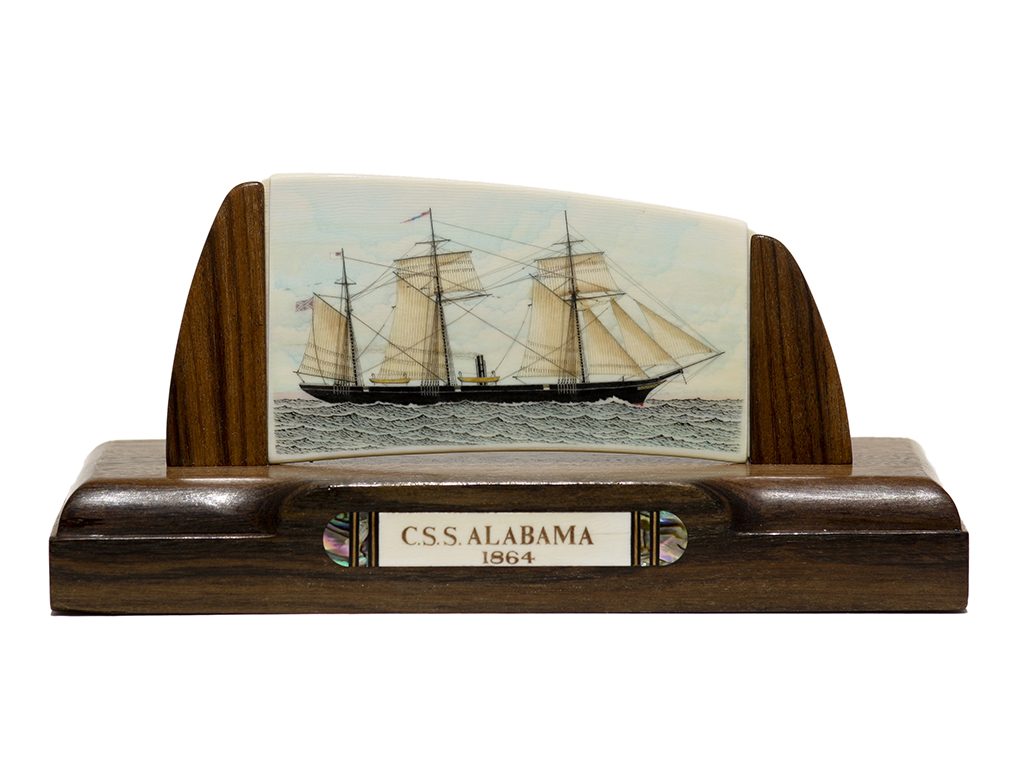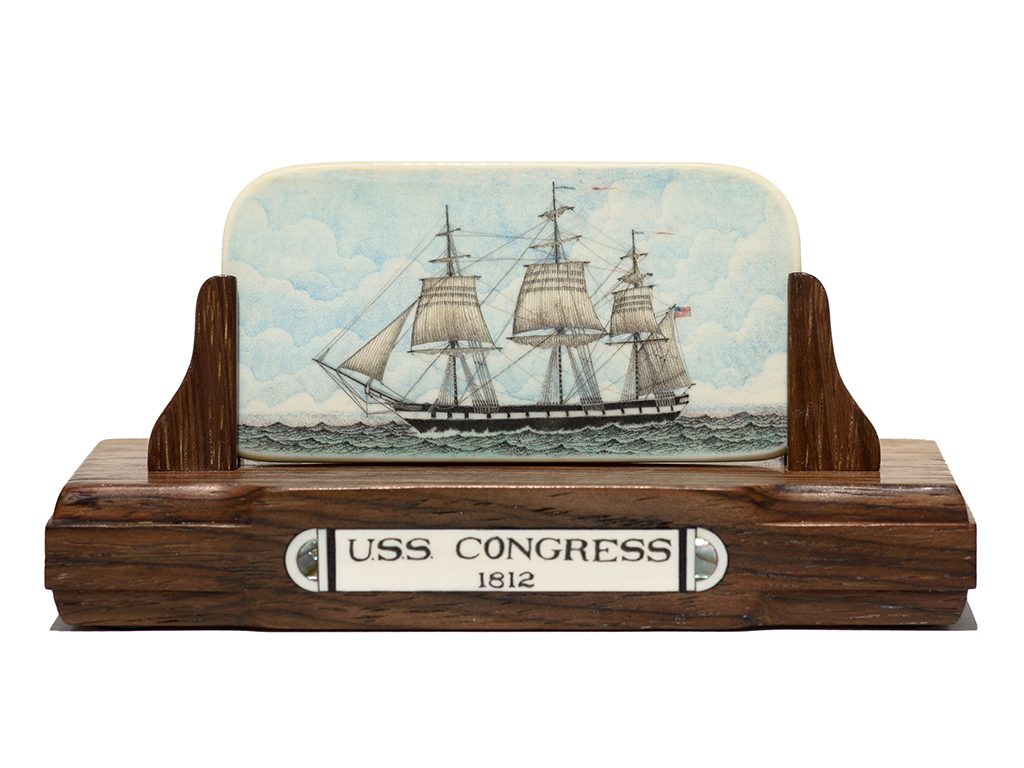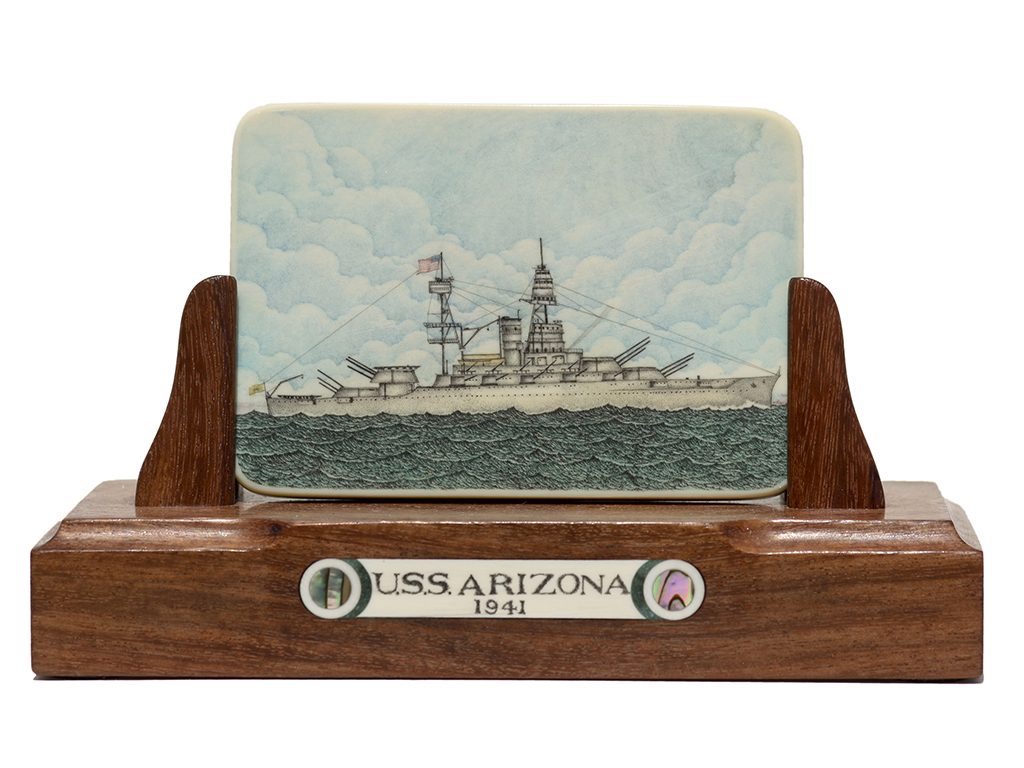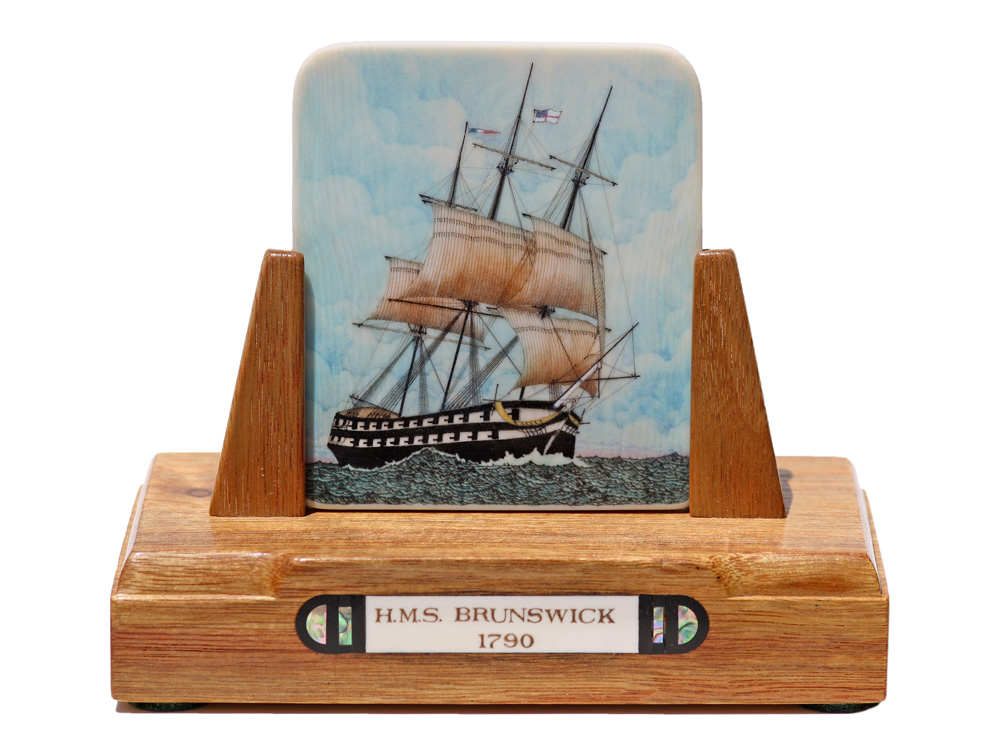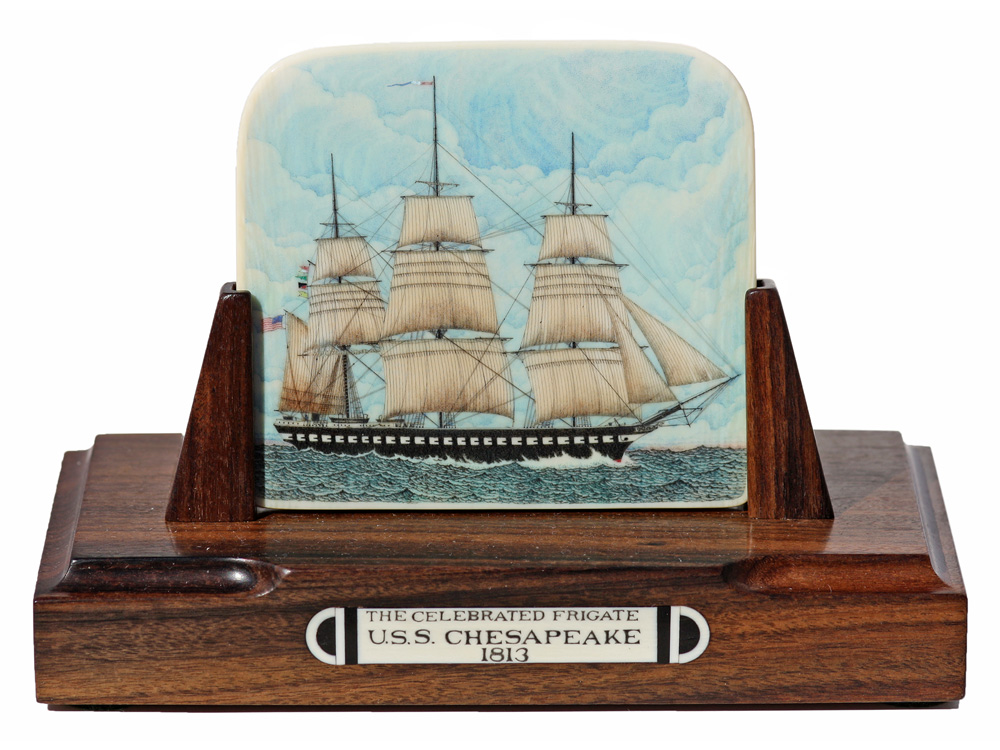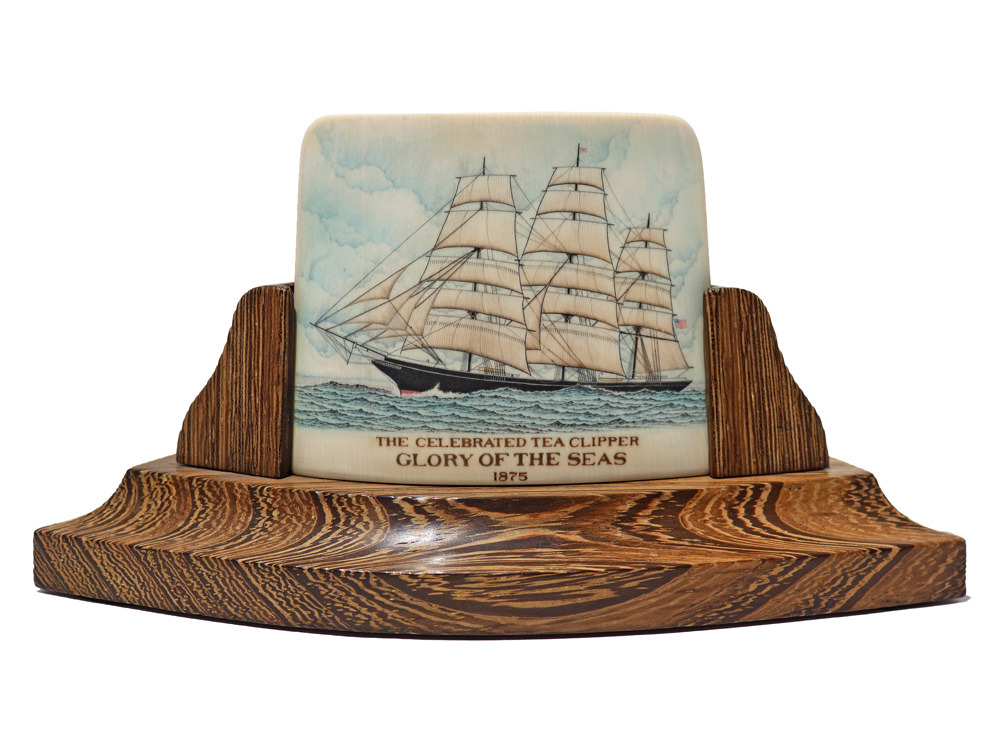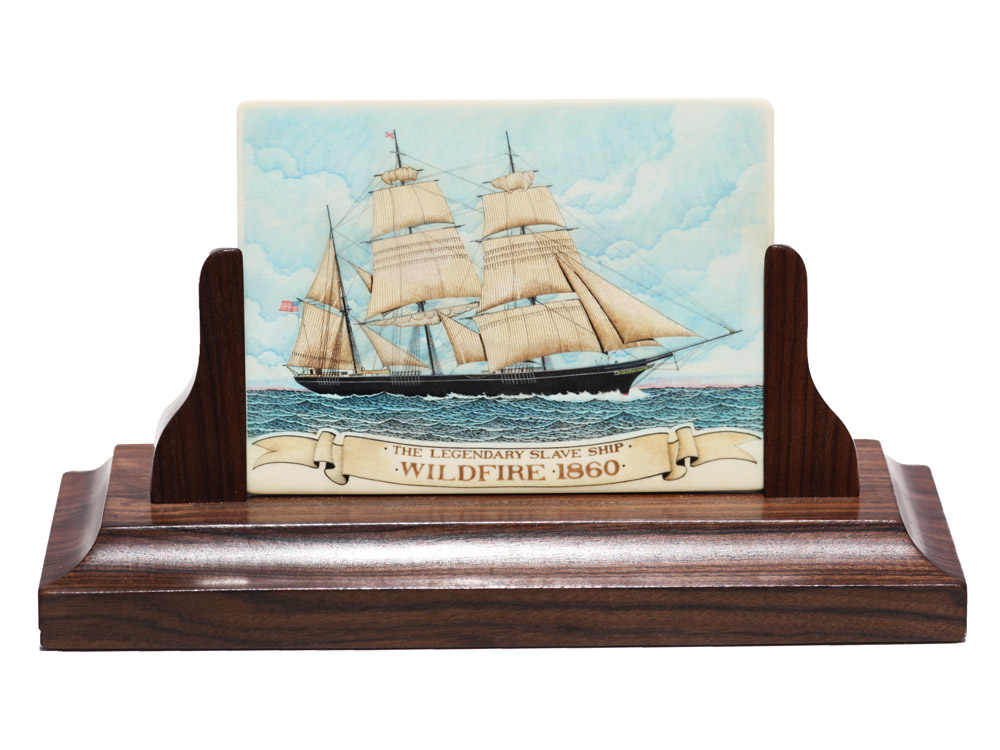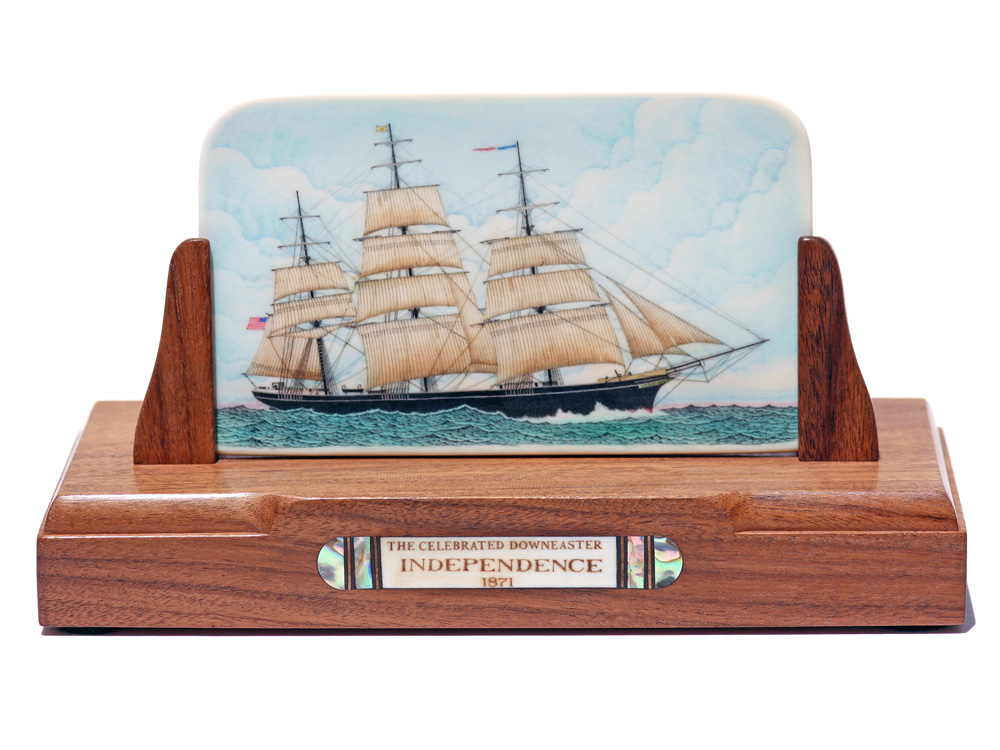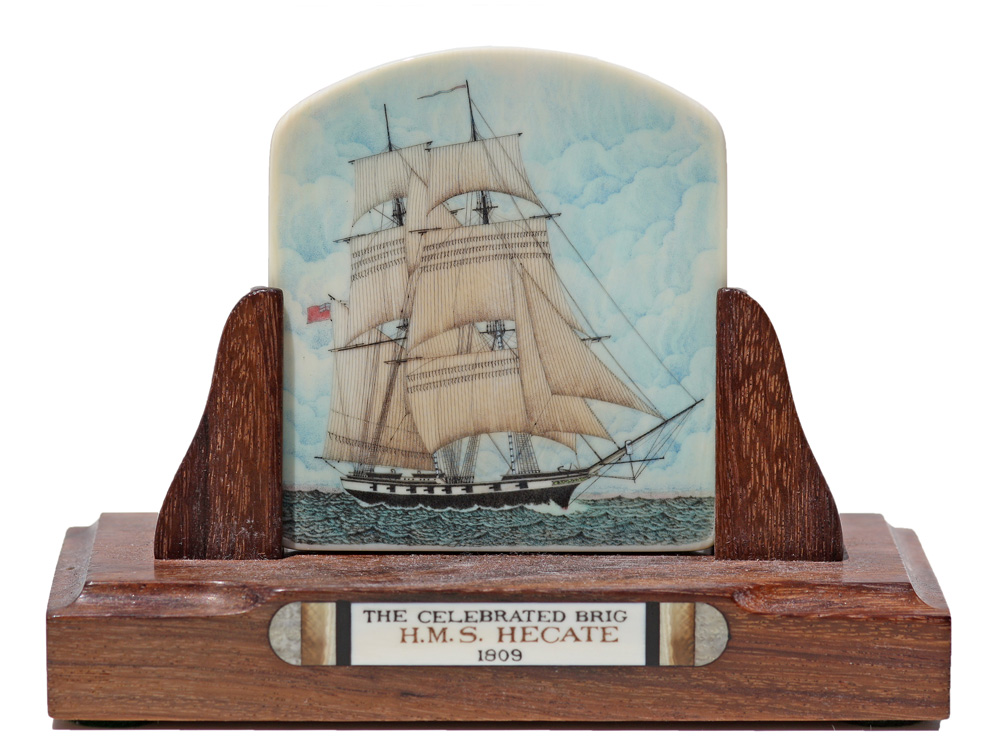SCRIMSHAW ARTIST View all Joel Cowan scrimshaw pieces Scrimshaw artist biography coming soon.
Color scrimshaw on pre-ban African Ivory by Joel Cowan. When it comes to detailed (and I do mean detailed) ship portraits, there is Joel Cowan and then there is everyone else. Working in time consuming stipple technique, Cowan does thousands and thousands of tiny dots for each prized portrait. We have worked with Cowan for several decades and are fortunate enough to have accumulated several of his pieces. These are prized by knowing collectors throughout the U.S. and abroad and many collectors have several Cowans in their collections. Now is the perfect opportunity to acquire one for yourself.
Notice:
This scrimshaw is done on pre-ban African ivory. Since the passage of the CITIES Treaty in 1973, there has been no African ivory brought into the U.S. However, ivory that was in the U.S. prior to 1973 can be legally sold and shipped within the U.S. However, new legislation taking effect in 2016 restricts pre-ban African Ivory from being shipped interstate. It can only legally be shipped intrastate, (within the state). All of our pre-ban ivory is located with our associate in the state of Florida. It can be purchased directly from our website and shipped only to an address within the state of Florida. If one has a relative, trusted friend or business associate within the state of Florida, we can ship to that specified address in order to comply with the new Federal legislation. The scrimshaw can then be forwarded it to you and everyone complies with the law. Any questions email or call us.
Color scrimshaw on pre-ban African Ivory by Joel Cowan. When it comes to detailed (and I do mean detailed) ship portraits, there is Joel Cowan and then there is everyone else. Working in time consuming stipple technique, Cowan does thousands and thousands of tiny dots for each prized portrait. We have worked with Cowan for several decades and are fortunate enough to have accumulated several of his pieces. These are prized by knowing collectors throughout the U.S. and abroad and many collectors have several Cowans in their collections. Now is the perfect opportunity to acquire one for yourself.
Taken from the internet:
USS Congress, one of six frigates authorized by congressional enactment of 27 March 1794, was built by naval constructor, J. Hackett, at Portsmouth, N.H. Her construction, interrupted upon conclusion of peace terms with Algiers, was resumed with the imminence of naval war with France, and she was launched 15 August 1799 under the command of Captain J. Sever.
After outfitting at Portsmouth and Boston, Congress proceeded to Newport, R.I., in December 1799 then to sea to protect commerce from French despoilment. She started her maiden voyage, on 6 January 1800, in company with frigate USS Essex, escorting merchant ships to the East Indies; however, she lost her mast when only 6 days out and returned to the States. Following repairs at Hampton Roads she again sailed for the West Indies on 26 July.
On 29 August she recaptured the merchant brig, Experiment, seized 3 days previously by a French privateer. Sailing on the Santo Domingo station until the following year, Congress returned to Boston in April 1801 and was thereafter placed in ordinary at Washington, D.C.
The continuing piracy of the Barbary States occasioned Congress’ return to commission in April 1804. Under Captain John Rodgers she departed for Hampton Roads to join the ships of the Mediterranean Squadron under the command of Commodore Samuel Barren. Arriving at Gibraltar on 11 August, Congress cruised vigilantly in the Mediterranean for 11 months. Now commanded by Stephen Decatur, she returned to the United States in November, carrying the Tunisian ambassador to the United States. She again laid up in ordinary at Washington until 1811.
A period of extensive repair preceded recommissioning of Congress in the fall of 1811, under the command of Captain J. Smith. Early in 1812 before war broke out she made several brief cruises along the eastern coast. Congress was assigned to the squadron of Commodore John Rodgers, patrolling the North Atlantic, from June to August 1812. She made her second cruise against the enemy in company with the frigate USS President, sailing from Boston on 8 October and capturing nine prizes before returning on 31 December. On 30 April 1813, Congress again put to sea, cruising off the Cape Verde Islands and the Brazil coast where she captured four small enemy ships. On 14 December she returned to Portsmouth for repairs, remaining there for the duration.
From October 1822 to April 1823 Congress operated against the West Indies pirates. During the second half of 1823 she carried the United States Ministers to Spain and the Argentine Republic. In 1824 Congress was placed in ordinary at Norfolk until December when she was towed to Washington for repairs. In November 1829 she returned to Norfolk where she served as receiving ship for several years and then was laid up in ordinary. A naval survey in 1834 found her unfit for repair and she was broken up at the Norfolk Navy Yard by order of the Navy Commissioner.
Notice:
This scrimshaw is done on pre-ban African ivory. Since the passage of the CITIES Treaty in 1973, there has been no African ivory brought into the U.S. However, ivory that was in the U.S. prior to 1973 can be legally sold and shipped within the U.S. However, new legislation taking effect in 2016 restricts pre-ban African Ivory from being shipped interstate. It can only legally be shipped intrastate, (within the state). All of our pre-ban ivory is located with our associate in the state of Florida. It can be purchased directly from our website and shipped only to an address within the state of Florida. If one has a relative, trusted friend or business associate within the state of Florida, we can ship to that specified address in order to comply with the new Federal legislation. The scrimshaw can then be forwarded it to you and everyone complies with the law. Any questions email or call us.
Color scrimshaw on pre-ban African Ivory by Joel Cowan. When it comes to detailed (and I do mean detailed) ship portraits, there is Joel Cowan and then there is everyone else. Working in time consuming stipple technique, Cowan does thousands and thousands of tiny dots for each prized portrait. We have worked with Cowan for several decades and are fortunate enough to have accumulated several of his pieces. These are prized by knowing collectors throughout the U.S. and abroad and many collectors have several Cowans in their collections. Now is the perfect opportunity to acquire one for yourself.
Notice:
This scrimshaw is done on pre-ban African ivory. Since the passage of the CITIES Treaty in 1973, there has been no African ivory brought into the U.S. However, ivory that was in the U.S. prior to 1973 can be legally sold and shipped within the U.S. However, new legislation taking effect in 2016 restricts pre-ban African Ivory from being shipped interstate. It can only legally be shipped intrastate, (within the state). All of our pre-ban ivory is located with our associate in the state of Florida. It can be purchased directly from our website and shipped only to an address within the state of Florida. If one has a relative, trusted friend or business associate within the state of Florida, we can ship to that specified address in order to comply with the new Federal legislation. The scrimshaw can then be forwarded it to you and everyone complies with the law. Any questions email or call us.
Color scrimshaw on pre-ban African Ivory by Joel Cowan. When it comes to detailed (and I do mean detailed) ship portraits, there is Joel Cowan and then there is everyone else. Working in time consuming stipple technique, Cowan does thousands and thousands of tiny dots for each prized portrait. We have worked with Cowan for several decades and are fortunate enough to have accumulated several of his pieces. These are prized by knowing collectors throughout the U.S. and abroad and many collectors have several Cowans in their collections. Now is the perfect opportunity to acquire one for yourself.
Taken from the internet:
HMS Brunswick was a 74-gun third rate ship of the line of the Royal Navy, launched on 30 April 1790 at Deptford. Brunswick’s first captain, Sir Hyde Parker, was appointed in May 1790 during the Spanish Armament. At the end of that year he was superseded by Sir Roger Curtis, under whom Brunswick spent most of 1791 at Spithead until the settlement of the Russian Armament without hostility in late August. She then paid off, but was immediately recommissioned to serve as a guardship in Portsmouth harbor, and continued in that role through 1792, except for a brief period spent in the “Evolution Squadron”. On 29 October 1792, three condemned mutineers of the Mutiny on the Bounty were hanged from her yardarms.
Following the outbreak of the French Revolutionary War Captain John Harvey took command of Brunswick, and saw service in the Channel Fleet under the overall command of Admiral Earl Howe. She fought at the Glorious First of June in 1794, suffering the highest casualty toll of any Royal Navy ship present in the battle, with 45 killed and 114 wounded, including Captain Harvey who died of the wounds he received while sinking the French ship Vengeur du Peuple. William Browell was made acting captain. Having lost her mizzenmast in the action, Brunswick drifted away to leeward of the retreating enemy fleet, but made all available sail to head northward for the safety of a home port.
Under Captain Lord Charles Fitzgerald she was part of Admiral William Cornwallis’s squadron which fell in with and escaped from a much superior French fleet in June 1795. She sailed to Jamaica carrying the flag of Rear-Admiral Richard Rodney Bligh in June 1796, and remained on that station until 1800. In 1812 Brunswick was on harbor service, and she was broken up in 1826.
Notice:
This scrimshaw is done on pre-ban African ivory. Since the passage of the CITIES Treaty in 1973, there has been no African ivory brought into the U.S. However, ivory that was in the U.S. prior to 1973 can be legally sold and shipped within the U.S. However, new legislation taking effect in 2016 restricts pre-ban African Ivory from being shipped interstate. It can only legally be shipped intrastate, (within the state). All of our pre-ban ivory is located with our associate in the state of Florida. It can be purchased directly from our website and shipped only to an address within the state of Florida. If one has a relative, trusted friend or business associate within the state of Florida, we can ship to that specified address in order to comply with the new Federal legislation. The scrimshaw can then be forwarded it to you and everyone complies with the law. Any questions email or call us.
Color scrimshaw on pre-ban African Ivory by Joel Cowan. When it comes to detailed (and I do mean detailed) ship portraits, there is Joel Cowan and then there is everyone else. Working in time consuming stipple technique, Cowan does thousands and thousands of tiny dots for each prized portrait. We have worked with Cowan for several decades and are fortunate enough to have accumulated several of his pieces. These are prized by knowing collectors throughout the U.S. and abroad and many collectors have several Cowans in their collections. Now is the perfect opportunity to acquire one for yourself.
Taken from the internet:
The Capture of USS Chesapeake, or the Battle of Boston Harbor, was fought on 1 June 1813, between the Royal Navy’s frigate HMS Shannon and American frigate USS Chesapeake, as part of the War of 1812 between the United States and Great Britain. The Chesapeake was captured in a brief but intense action in which over 80 men were killed. This was the only frigate action of the war in which there was no preponderance of force on either side.
At Boston, Captain James Lawrence took command of Chesapeake on 20 May 1813, and on 1 June, put to sea to meet the waiting HMS Shannon, the frigate whose written challenge had just missed Chesapeake ’s sailing. Chesapeake suffered early in the exchange of gunfire, having her wheel and fore topsail halyard shot away, rendering her unmanoeuvrable. Lawrence himself was mortally wounded and was carried below. The American crew struggled to carry out their captain’s last order, “Don’t give up the ship!”, but the British boarding party overwhelmed them. The battle was notably intense but of short duration, lasting ten to fifteen minutes, in which time 252 men were killed or wounded. Shannon ’s Captain Philip Broke was severely injured in fighting on the forecastle. Chesapeake and her crew were taken to Halifax, Nova Scotia, where the sailors were imprisoned; the ship was repaired and taken into service by the Royal Navy. She was sold at Portsmouth, England in 1819 and broken up. Surviving timbers were used to build the nearby Chesapeake Mill in Wickham and can be seen and visited to this day.
Notice:
This scrimshaw is done on pre-ban African ivory. Since the passage of the CITIES Treaty in 1973, there has been no African ivory brought into the U.S. However, ivory that was in the U.S. prior to 1973 can be legally sold and shipped within the U.S. However, new legislation taking effect in 2016 restricts pre-ban African Ivory from being shipped interstate. It can only legally be shipped intrastate, (within the state). All of our pre-ban ivory is located with our associate in the state of Florida. It can be purchased directly from our website and shipped only to an address within the state of Florida. If one has a relative, trusted friend or business associate within the state of Florida, we can ship to that specified address in order to comply with the new Federal legislation. The scrimshaw can then be forwarded it to you and everyone complies with the law. Any questions email or call us.
Color scrimshaw on pre-ban African Ivory by Joel Cowan. When it comes to detailed (and I do mean detailed) ship portraits, there is Joel Cowan and then there is everyone else. Working in time consuming stipple technique, Cowan does thousands and thousands of tiny dots for each prized portrait. We have worked with Cowan for several decades and are fortunate enough to have accumulated several of his pieces. These are prized by knowing collectors throughout the U.S. and abroad and many collectors have several Cowans in their collections. Now is the perfect opportunity to acquire one for yourself.
Taken from the internet:
Among the foremost icons of the 19th century were the clipper ships. They were built to carry high value cargo over great distances with speed. The most famous designer of these ships was Donald McKay, a Canadian-born American. McKay designed and built clipper ships beginning in the 1850s. The Glory of the Seas was to be his finest effort. He bet all his personal assets to build the ship on speculation. The Glory of the Seas was launched in 1869; on her maiden voyage she made a record run of 94 days from New York to San Francisco. Her arrival there was a great event. She was admired for the sumptuousness of her craftsmanship. Unfortunately, word of the instability of McKay’s financial condition preceded the vessel, and McKay was compelled to sell the ship in San Francisco. McKay never financially recovered. She made ocean voyages until the last years of the 19th century. She was then put into the coast-wise lumber and coal trade. In the early part of the 20th century she was laid up and subsequently used as a floating cannery and finally as a storage hulk. She was burned for her metal south of Brace Point in Seattle in 1923.
Notice:
This scrimshaw is done on pre-ban African ivory. Since the passage of the CITIES Treaty in 1973, there has been no African ivory brought into the U.S. However, ivory that was in the U.S. prior to 1973 can be legally sold and shipped within the U.S. However, new legislation taking effect in 2016 restricts pre-ban African Ivory from being shipped interstate. It can only legally be shipped intrastate, (within the state). All of our pre-ban ivory is located with our associate in the state of Florida. It can be purchased directly from our website and shipped only to an address within the state of Florida. If one has a relative, trusted friend or business associate within the state of Florida, we can ship to that specified address in order to comply with the new Federal legislation. The scrimshaw can then be forwarded it to you and everyone complies with the law. Any questions email or call us.
Color scrimshaw on pre-ban African Ivory by Joel Cowan. When it comes to detailed (and I do mean detailed) ship portraits, there is Joel Cowan and then there is everyone else. Working in time consuming stipple technique, Cowan does thousands and thousands of tiny dots for each prized portrait. We have worked with Cowan for several decades and are fortunate enough to have accumulated several of his pieces. These are prized by knowing collectors throughout the U.S. and abroad and many collectors have several Cowans in their collections. Now is the perfect opportunity to acquire one for yourself.
Information from the internet:
Slave ships were large cargo ships specially converted for the purpose of transporting slaves, especially newly purchased African slaves to the Americas. Wildfire, a barque, arrested off the Florida coast by the US Navy in 1860; carrying 450 slaves.
Northern ships engaged in the Triangle Trade until the eve of the Civil War. In 1860 the slaver Wildfire set sail from New York for St. Thomas with a cargo of calico and other cotton goods. Its next stop was the Congo River, where the crew installed a new deck in the hold, creating a cramped space with four feet of clearance, specifically to house captives. In March the ship set sail for Cuba, with 615 naked prisoners, most of them teenagers. 450 captives were lodged on deck, the rest were crammed below. Ninety people died during the five weeks it took the ship to reach the coast of Cuba, where it was captured by the US Naval steamer Mohawk. The Mohawk towed the ship to Fort Taylor on Key West. There the captives were lodged in a brand new stockaded barracks on three acres of land outside of town. Within a month more than 900 more captives were brought to the compound, taken by the US Navy from the slave ships William and Bogota, both of which, like the Wildfire, had started their triangular voyages in New York City. By the end of May, with 1,350 people crowded into the barracks, Congress contracted with the American Colonization Society to ship the captives back to Africa. By the end of June all the captives had been abandoned in Liberia — save the 295 unfortunate souls who had died in the Florida stockade.
Notice:
This scrimshaw is done on pre-ban African ivory. Since the passage of the CITIES Treaty in 1973, there has been no African ivory brought into the U.S. However, ivory that was in the U.S. prior to 1973 can be legally sold and shipped within the U.S. However, new legislation taking effect in 2016 restricts pre-ban African Ivory from being shipped interstate. It can only legally be shipped intrastate, (within the state). All of our pre-ban ivory is located with our associate in the state of Florida. It can be purchased directly from our website and shipped only to an address within the state of Florida. If one has a relative, trusted friend or business associate within the state of Florida, we can ship to that specified address in order to comply with the new Federal legislation. The scrimshaw can then be forwarded it to you and everyone complies with the law. Any questions email or call us.
Color scrimshaw on pre-ban African Ivory by Joel Cowan. When it comes to detailed (and I do mean detailed) ship portraits, there is Joel Cowan and then there is everyone else. Working in time consuming stipple technique, Cowan does thousands and thousands of tiny dots for each prized portrait. We have worked with Cowan for several decades and are fortunate enough to have accumulated several of his pieces. These are prized by knowing collectors throughout the U.S. and abroad and many collectors have several Cowans in their collections. Now is the perfect opportunity to acquire one for yourself.
Notice:
This scrimshaw is done on pre-ban African ivory. Since the passage of the CITIES Treaty in 1973, there has been no African ivory brought into the U.S. However, ivory that was in the U.S. prior to 1973 can be legally sold and shipped within the U.S. However, new legislation taking effect in 2016 restricts pre-ban African Ivory from being shipped interstate. It can only legally be shipped intrastate, (within the state). All of our pre-ban ivory is located with our associate in the state of Florida. It can be purchased directly from our website and shipped only to an address within the state of Florida. If one has a relative, trusted friend or business associate within the state of Florida, we can ship to that specified address in order to comply with the new Federal legislation. The scrimshaw can then be forwarded it to you and everyone complies with the law. Any questions email or call us.
Color scrimshaw on pre-ban African ivory by Joel Cowan. Long recognized as the most precise ship scrimshander ever, Cowan’s work continues to impress everyone. His stipple work is in a class by itself. As far as his lettering, no one comes close. Cowan works directly from the actual plans of the ship and is completely accurate in his depiction. Cowan works exclusively for Scrimshaw Gallery and any scrimshaw collection, beginning or long time, should include several Joel Cowan pieces while they are available.
Information from internet:
HMS Hecate was a Royal Navy 18-gun Cruizer-class brig-sloop, built by John King at Upnor and launched in 1809. After serving in the British Navy, essentially entirely in the East Indies, she served in the Chilean Navy as Galvarino from 1818 until she was broken up in 1828.
Hecate was commissioned in 1809 under Commander William Buchanan. Commander Edward Wallis Hoare replaced him in October and sailed for the East Indies on 31 October. In 1810, Lieutenant George Rennie became acting commander and Hecate was detailed for service with the squadron under Admiral Albemarle Bertie engaged in the Invasion of Ile de France. In 1814 she would share in the prize money resulting from the capture of the island.
In 1811 she was under Commander Thomas Graham until July, when Commander Henry John Peachey assumed command. From 3 August she was part of the fleet involved in the invasion of Java, which ended with the surrender of Dutch and French forces on 16 September. For this service all of her crew who had survived to 1847 and chose to were entitled to claim the Naval General Service Medal with clasp “Java”. In 1815 Hecate also shared in the prize money arising out of the invasion.
Peachey was promoted to post-captain on 7 August 1812 and removed to Malacca. Lieutenant William Case may have followed Peachey as acting commander, but then the newly promoted Commander Case took command of Samarang, and Commander Joseph Drury transferred from Samarang to Hecate. At some point in 1812 pirates from the Sultanate of Sambas, in western Borneo, captured nine sailors from Hecate and killed or enslaved them, after cutting their hamstrings or otherwise mutilating them. In June 1813 Hecate participated in a punitive expedition against the Sultanate of Sambas.
Hecate sailed for Madras in January 1814 and her next commander, from 4 February 1814, was Commander John Allen. On 20 November 1815 command passed to John Reynolds.
Hecate arrived in Portsmouth on 17 August 1816, from Trincomalee, which she had left on 20 March. She had sailed via the Cape of Good Hope and Saint Helena. On 22 May 1817 the Admiralty offered Hecate, then lying at Portsmouth, for sale.
On 30 October 1817 the Admiralty sold Hecate to Mr. Parkin for £860. In Buenos Aires she was also known as the name Lucy. She was resold to the Chilean Revolutionary government, arriving in Chile on 9 November 1818 under the command of Captain Guise.[8] She served the new Chilean Navy as Galvarino, first under Captain Spry (until Admiral Thomas Cochrane dismissed him) and then under Captain Winter. On 2 October 1819 she was at the second attack on Callao where a lieutenant onboard was killed by Spanish fire. In 1821, while under the command of Captain I. Esmond, her crew mutinied and refused to go to sea until they had received their back pay and prize money.
She participated in the Freedom Expedition of Peru, but after the final confrontation between San Martin and Cochrane and the subsequent loss of many officers and seamen to the new Peruvian Navy, the Lautaro and Galvarino were sent back to Valparaiso to ease the demand for seamen.
Notice:
This scrimshaw is done on pre-ban African ivory. Since the passage of the CITIES Treaty in 1973, there has been no African ivory brought into the U.S. However, ivory that was in the U.S. prior to 1973 can be legally sold and shipped within the U.S. However, new legislation taking effect in 2016 restricts pre-ban African Ivory from being shipped interstate. It can only legally be shipped intrastate, (within the state). All of our pre-ban ivory is located with our associate in the state of Florida. It can be purchased directly from our website and shipped only to an address within the state of Florida. If one has a relative, trusted friend or business associate within the state of Florida, we can ship to that specified address in order to comply with the new Federal legislation. The scrimshaw can then be forwarded it to you and everyone complies with the law. Any questions email or call us.
- 1
- 2

